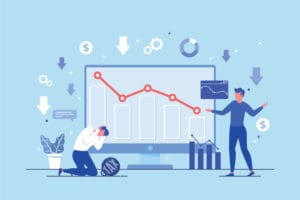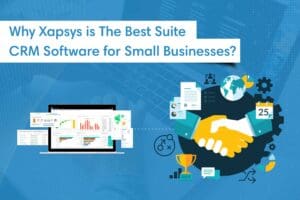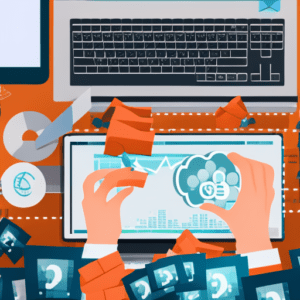Future of CRM & Workflow Management in 2023 & Beyond
Published on 16 January 2023 by Ankit Kumar
The future is here- at least in the field of customer relationship management (abbreviated as CRM)- one of the fastest-growing category enterprise software. The future of CRM and Workflow Systems is bright- from small businesses to global enterprises, teams are now adopting CRM to enhance their customer experience and acquire and retain new customers. The customer-centric insights are changing businesses for the better.
What is a CRM?
Customer Relationship Management is the triple combination of practices, technologies and strategies businesses use to manage and analyse customer interactions and data throughout the customer lifecycle. The goal is simple: improve customer service relations and drive sales growth.
The customer relationship management system is at the heart of every business and involves significant annual spending for most businesses. This is a technology of the future since it supports customers end to end throughout their journey. Customers are fundamentally changing, and it goes beyond simple demographics. Customer is your king, and what better tool than a CRM to collect and harness information? The better the marketing data and customer-centric experience, the better the marketing strategy. As you read this article, we will enlighten you about the birth of CRM as a modern business tool and how businesses are scaling using this tool.
What is a Workflow Management System in CRM?
Workflow is automation in a CRM, which is a valuable tool for most businesses. You can create rules to automate the day-to-day tasks that take too much time. Specific actions can be automated, such as assigning a new task to a user, sending proactive alerts to your sales team members, and updating the value of a field on the record.
The creator of the workflow system is ideally the one in control of the triggers and actions. The function of a workflow is to automate your daily processes, thereby saving your business time and money so that you can focus on solving customer queries.
In simple language, workflow describes a sequence of tasks or progressive steps leading to an end goal in a business process.
Back in the heyday, CRM workflows were quite simple. For example, these were mapped out and presented as charts, bars or graphs for team members to analyse. However, modern CRM solutions are embedded with automated workflows, eventually leading to an efficient team. Today some of the most agile, all-encompassing CRM solutions are available in the market for modern business problems.
Why Will Every Business Want to Use CRM with Workflow Systems in the Future?
The future of a CRM system depends on the technology you want to implement and how it enables your team to work together and support your customers better. When investing in a CRM, you must find a system that will make your business move quickly. This means that the tools used should be intuitive, cloud-based, optimised and customisable per your business needs.
The CRM philosophy is simple. Your customer is your king, and your CRM is a single source of truth- that unifies operations across departments, ultimately improving your business efficiency and making your customers return.
Now, let’s come to the question, why will businesses want to integrate CRM into their system? Let’s take a look at this.
Today’s highly competitive world is choc-a-bloc with so many products and services to choose from. Hence customers are getting pickier, and loyalty seems to be a thing of the past. You must have noticed that the moment a product is launched in the market, it only takes a short amount of time before it becomes a commodity. The rush of customers increases and decreases with the demand for the commodity, and this is when CRM comes to the forefront. Since CRM is an important business tool, it assists in prioritising sales and marketing efforts when dealing with different customer groups. It also helps businesses understand customers’ needs and improve their products accordingly. Although some people think that CRM is just a technology, it is more than that. Let’s find out how CRM plays a vital role in customer centricity, customer management and automation.
- No Paper Trail
The concept of a digital workplace was to reduce paper trails. Employees spend hours collating paper-based documents and storing them. Imagine misplacing or losing these documents. Scary right? Today we have the technology to reduce these risks, and CRM does just that. Workflows keep digital records of essential documents, automate tasks and alert those who need to take action, recording every action being taken.
- Eliminate Duplication
Integrating CRM into your application allows you to have a seamless data flow to, from and within the CRM. You can also integrate ERP tools such as Sage or Xero with CRM. This allows you to carry out activities from a single platform, thereby reducing the risk of data duplication, which can happen whilst toggling between different applications.
- Customer Intelligence
Customers are more in touch with their needs, with data being available at their fingertips. They know where to buy it, how much to buy it for and what to buy. When it comes to business, it is essential to predict customer behaviour. But how exactly would you do that? The quick answer is: through customer intelligence. Customer intelligence is the knowledge of why customers behave as they do, which allows businesses to adapt and meet customer needs- and CRM assists you with this.
- API & Integration
One essential technology that allows cloud-based CRM applications to adapt to the demands of the sales and marketing teams is APIs. Additionally, they are enabling a previously unheard-of level of analytics-driven insights. With greater flexibility and versatility in designing entirely new GUIs, workflows, process steps, and screen designs, APIs are already starting to become more customer-centric in their design. The nature of cloud platforms will be redefined over time by APIs. Today, almost all CRM providers have APIs, some of which are more developed and scalable than others.
- Next Level Automation
Businesses have both business- and customer-facing processes.
Sales, marketing, and customer service are examples of business-facing processes which improve how effectively a business operates. Business-facing processes also include budgeting and planning.
A CRM strategy primarily focuses on processes that interact with customers and improves them so that they better serve their needs. CRM automation is a technique for streamlining procedures and increasing productivity in customer relationship management by automating necessary but monotonous manual tasks. Many B2B and B2C businesses use CRM systems to streamline operations and simplify challenging tasks.
- Customisable
Your company can significantly benefit by implementing a CRM (customer relationship management) solution. A CRM solution is a platform that gathers data from your clients and prospects via various channels and consolidates it in one place. Using a CRM makes updating customer information much more straightforward. It gives teams across your organisation quick access to up-to-date crucial customer data whenever needed.
However, the success of your CRM solution will be significantly influenced by your capacity to use its features to satisfy your particular requirements.
Many businesses believe that by paying extra for customised CRM systems, their unique needs will be met. Most CRM solutions only allow you to customise your CRM using the available default and custom properties, formulas, and workflows. Xapsys can tailor features and even develop functionality within its platform for truly custom CRM & workflow systems.
No matter your chosen CRM system, you should know there isn’t a “one-size-fits-all” CRM. For this reason, it’s essential to know how to customise your CRM to meet your company’s needs precisely and what different suppliers mean by the term ‘customisable’.
- Email Automation to Keep Retain Your Customers
CRM software combines several tools into one and is utilised by numerous departments for various tasks. For instance, a sales team can utilise the most basic functions of a CRM, like lead tracking and communication logging.
Dialers, chatbots, analytics, and project management tools are all features of some CRMs that streamline crucial work tasks from a single dashboard.
Regardless of their features, most CRM software includes workflows, which allow one customer action—often referred to as a “trigger“—to produce a second set of actions instantly. Therefore, your team doesn’t have to manually complete all the necessary steps after a customer takes a particular action. Instead, the CRM takes care of it automatically.
One such automation is email automation. It is simpler to convert qualified leads into paying customers. Furthermore, automating the qualification procedure can free up time, allowing your salespeople to concentrate on closing deals.
Using email follow-ups is one method of doing this. One of the most effective ways to contact leads is via email. You can track the performance of your emails using integrated marketing software.
- Keep Your Employees Engaged By Automating Task Assignment
CRM is a valuable tool used by most marketers to manage their relationships with customers. It is invaluable in understanding the customer base and planning the following marketing strategies.
Automating your marketing and sales efforts within your CRM enables you to nurture prospects with human connection at every stage.
Using task automation in your CRM can create opportunities to strengthen customer relationships, streamline data points, and increase alignment between the sales and marketing teams.
- Connect With Leads Faster
Many channels come to mind when you hear “lead generation.” Many options are available, from traditional radio and television advertisements to modern social media platforms.
CRM is one such channel that has grown incredibly popular, and rightfully so. It assists in lead generation from multiple sources and tracking their movement through the sales funnel.
- Increase Conversion Rate
Most businesses understand the importance of effectively managing their customers. Without knowing this, you will only lower your potential to find new customers. Proper customer management relies heavily on CRM systems and their utilisation. Some of you might be unfamiliar with what conversion signifies. Simply put, conversion is when a member of your audience converts as a customer. Boosting your conversion rate is rarely straightforward. In most cases, you need to understand your competition deeply. Fortunately, even small businesses can easily tackle conversions with modern CRM solutions.
Reasons Not to Use a CRM and Workflow System?
Just like a coin has two sides: a head & tail, Customer Relationship Management also has its pros and cons. Much as its pros are captivating, the cons are equally risky. When it comes to CRM, the core task is to improve business efficiency, gather customer data swiftly, identify valuable customers and improve customer loyalty.
Like every other business tool, CRM is not foolproof and consider that 55% of all CRM projects do not produce the desired results. According to a survey conducted by Bain (2002), CRM ranked in the bottom three of all satisfactory business tools.
One research suggests that the primary reason why most CRMs fail successful integration is that employees do not understand how to navigate around the system. Any new business tool can be pretty fascinating initially, promising to make any problems disappear, but implementing CRM without analysing requirements and strategies is a glaring error!
The other scenario when CRM implementation fails is when you try to integrate a new system without identifying your business’s core areas, such as job descriptions, performance strategies, training programs and so on. Executives often do not understand that implementing a CRM with workflow management software without understanding the internal processes is a sure miss!
Many executives make the mistake of assuming that simply depending on technology would make business processes smooth. But this isn’t so. Though CRM is customer-centric, there are other effective ways to manage your customers. Merely depending on technological processes is a costly pitfall.
Well, relationships are always a two-way street, and if you want to draw in affluent customers, do they want to deal with you too? Fail to build a valuable relationship with your customers, and they are bound to be lost. Just because you have a CRM in place doesn’t always mean that is all.
Mananagent tools have come and gone, and CRM could be just another fad. Indeed CRM is a powerful idea, and it is by no means impossible to implement, provided you remember and avoid the pitfalls which could dilute your earnings or damage customer loyalty. While technology is a facilitator- one must not forget that it is a facilitator.
A Good CRM Automation Tool
CRM has come a long way since its inception. Today’s CRM is more versatile and adaptable for businesses of any size. With dozens of options in the market, it can be very overwhelming for you to pick the right one. This is why we took the painstaking task of making it easier for you to decide.
When it comes to CRM, most businesses have different sets of requirements. Some important ones are ease of usage, contact & sales management, customisation, access to reporting and automation.
It took us a few tests and trials to find out what we could do better to make your life easier. Xapsys CRM system is a customer-centric tool with features such as ERP integration to make the lives of your employees easier. Our tool seamlessly integrates ERP with your workflow system, allowing you to access everything simultaneously! No more fuss over using different tools for different tasks.
It’s A Tough Decision, But We Have Made It Easier For You
You are here today because your competitors are two steps ahead of you- with an intelligent CRM investment. Each moment you don’t know what a CRM is, two competitors take a step ahead of you. But worry not. We’ve got you covered.
Without further ado, integrate with Xapsys CRM & Workflow System as your top business tool and stay ahead of your competitors. Let’s get started!


